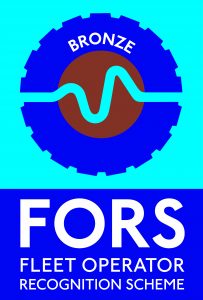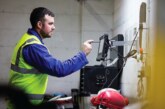Basic legal compliance exists for a good reason: to deliver a standard level of operational standards to which all must adhere. FORS aims to provide a pathway to operational excellence for all operators to make best practice a day-to-day objective throughout the industry. FORS Bronze accreditation is the first step for those choosing this pathway.
 The nature of FORS is such that, even at its entry level, any operator (provided they meet basic legal compliance) can join and begin the process of ensuring they meet FORS Bronze requirements ahead of their audit.
The nature of FORS is such that, even at its entry level, any operator (provided they meet basic legal compliance) can join and begin the process of ensuring they meet FORS Bronze requirements ahead of their audit.
Achieving FORS Bronze allows operators to prove they work above the basic legal minimum standards, and have access to a wealth of training and guidance on improving safety, efficiency and sustainability.
What’s more, because the FORS accreditation process is progressive, Bronze accredited operators are encouraged to not only maintain this accreditation, but to strive for continuous improvement and operational excellence.
Importantly, for companies wishing to begin the FORS Bronze accreditation process, FORS is accessible to any operator, regardless of its business interests, size and fleet make-up. A 300-stong fleet, or a single van operation, will receive the same level of training and support. The organisation believes any programme designed to raise standards must be industry wide, and fully inclusive.
FORS offers a free-to-attend ‘Going for Bronze’ workshop, specifically designed to guide and support operators through the process: from registration through to accreditation. It is also open to fleet operators ahead of a Bronze re-approval audit. To help operators avoid the pitfalls of a first time fail, FORS has identified the five most common reasons for failed Bronze audits, along with some top tips to guide operators approaching the audit.
Professional Development
One of the most common reasons operators fail the Bronze audit is not providing the required mandatory training courses or producing a professional development plan for all members of staff.
Top tips:
■ Develop a training plan for all transport staff. The plan should outline the type of training needed – this should include approved courses and when the courses are required to be delivered
■ Structure the training plan to include all transport employees, not just drivers. Toolbox talks and Driver CPC training (if in scope) should also be used as evidence of ongoing professional development
Vehicle Manoeuvring
If an operator fails, it could be because it did not have a policy and/or the appropriate risk assessments in place, did not communicate these to relevant staff, and/or did not get the transport staff to acknowledge receipt of these.
Top tips:
■ A policy needs to be in place regarding manoeuvring, including forward motion, turning, reversing, towing, uncoupling, and parking movements
■ Review the policy, and include the date the policy was reviewed
■ Name the person who carried out the policy review
■ Communicate the policy to transport related staff and check that they have acknowledged receipt
■ Provide risk assessments for vehicle manoeuvring
■ Have a system in place for recording near misses
Document Review
Companies must ensure policies and procedures are reviewed at least annually, or as and when required, if sooner, and senior management must acknowledge the review.
Top tips:
■ Review the company policies, procedures manual, risk assessments, training plans, other related documents and how any changes have been communicated to all transport related staff
■ Record all dates of minutes from review meetings over the past 12 months
■ Include details of the person who last reviewed the policies and procedures documents
■ Version control processes need to be in place to ensure that only the most current documents are issued to staff
Tyre and Fuel Management
Tyre and fuel management is an important aspect of keeping any fleet on the road. Operators need to ensure they have a fuel and tyre management policy in place to manage tyre wear, condition and disposal, and demonstrate tyre monitoring and fuel consumption management.
Top tips:
■ A policy needs to be in place to record and manage tyre wear, condition, pressure and tyre disposal
■ Review the policy as per the document review process, and include the date the policy was reviewed
■ Name the person who carried out the policy review
■ Operators need to demonstrate that they have a policy in place that’s fit for purpose regarding fuel management
■ Provide evidence of tyre wear and pressure analysis, and fuel usage
■ Record how the company ensures that tyres are disposed of correctly
Personal Safety in or around vehicles
A fail may be the result of not having a policy and/or appropriate risk assessments in place, not communicating these with staff, or failing to get the transport staff to acknowledge receipt.
Top tips:
■ Have a policy in place on personal safety in and around vehicles
■ Review the policy as per the document review process, and include the date the policy was reviewed
■ Name the person who carried out the policy review
■ Communicate the policy to transport related staff and check that it has been acknowledged
■ Provide risk assessments for working or travelling in, on and around the vehicles
■ Provide risk assessments for working at height
■ Communicate these to the transport related staff and check that they have been acknowledged
■ Provide risk assessments for passenger safety, and that passengers have been communicated to










